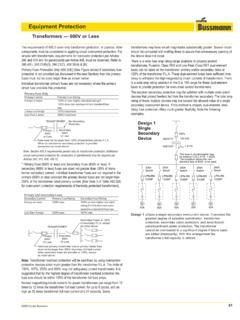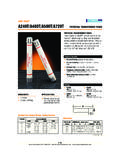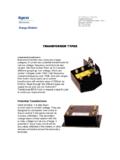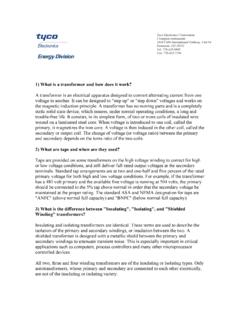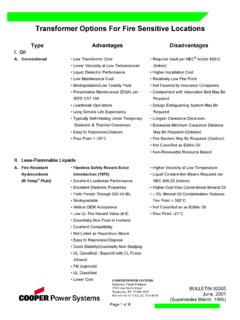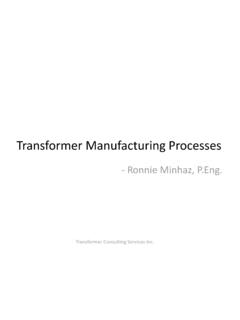Transcription of Transformer UPS vs. Transformerless UPS
1 LiiTransformer UPS vs. Transformerless UPS Balancing high levels of avai ab lity with effic ency Click a section below Introduction ENERGY EFFICIENCY comparisons Design factors that affect AVAILABILITY MAINTAINABILITY, service and safety ToTAL CosT of ownership CRITICAL QuEsTIoNs to ask Conclusion Introduction Today s IT, facilities and data center managers face the daunting challenge of maintaining a high availability data center while simultaneously increasing energy efficiency. This challenge, coupled with the need to quickly meet growth demands and provide an easily maintainable facility, makes selecting an uninterruptible power supply (uPs) platform a critical decision element. Not all uPs platforms are alike. one such design difference being analyzed today is differences between traditional Transformer -based UPS to Transformerless uPs technology for large enterprise data centers. This paper with embedded links and videos will highlight the most essential points IT managers need to know when evaluating the differing benefits and costs associated with Transformer -based uPs compared to Transformerless uPs design.
2 Topics highlighted include: Energy efficiency comparisons Design factors that affect availability Maintainability, service and safety Total cost of ownership The right uPs design strategy should enable a data center to balance lower costs and higher efficiencies with no compromise to overall availability and ability to ENERGY EFFICIENCY comparisons Design factors that affect AVAILABILITY MAINTAINABILITY, service and safety ToTAL CosT of ownership CRITICAL QuEsTIoNs to ask Conclusion Critical questions to ask > Click to watch The Executive Perspective Can t get to YouTube at work? Emerson Network Power | Efficiency Without Compromise E-Book series, Chapter 1 PG 1 ENERGY EFFICIENCY comparisons Fact: Energy efficiency is a top-of-mind concern for data center managers and Transformerless uPs designs can achieve higher efficiencies by replacing the uPs Transformer with solid-state circuits. As the graph demonstrates, when comparing like-for-like operating parameters, the Transformerless uPs achieves higher efficiencies compared to modern Transformer uPs designs but only at loaded capacities well over 40 percent.
3 100%Redundant uPs are typically loaded Introduction ENERGY EFFICIENCY comparisons Design factors that affect AVAILABILITY MAINTAINABILITY, Center Operating Range Typical Enterprise Data ToTAL CosT of ownership 95% service and safety less than 50 percent to ensure if one uPs goes down, the redundant uPs EffiCiEnCy can assume 100 percent of the load. Today s newest generation of Transformer -based uPs have been CRITICAL QuEsTIoNs to ask 90% Conclusion 85% engineered to optimize efficiency at less than half loads. Legacy 80% Transformer uPs do not optimize 10% 20% 30% 40% 50% 60% 70% 80% 90% 100% in this operating range. Load CapaCity 750kVA Transformer UPS 750kVA Transformerless UPS Legacy Transformer UPS Continue ..i> Click to watch White Board on Effic ency Can t get to YouTube at work? Emerson Net work Power | Efficiency Without Compromise E-Book series, Chapter 1 PG 2 ENERGY EFFICIENCY comparisons using an example of a typical large data center operation utilizing 750 kVA 2N redundant uPs, where uPs loaded at 40 percent capacity, a Transformer -based uPs actually reduces energy consumption costs by roughly $2,900 over ten years.
4 Points to consider: Example: 750 kVA, 2N Transformerless UpS Transformer UpS 750 750 Every data center is different, so compare kVA 675 675uPs efficiency with actual efficiency and kW 40% 40%local utility rates. % Load kW 270 270 Efficiency impact analysis must account PDu Transformer losses and potential Efficiency @ %Load* 2,576,471 2,573,667input isolation transformers . UPS Input kW-H Utility Rate ($/kwhr) Yearly Utility Cost $267,953 $267,661 Bottom line: small differences in 1-year cost difference ($291) ($2,916)efficiency can have minimal impact on 10-year cost difference * Efficiencies assume like for like operating parameters (double conversion mode, fan utilization, etc.) dollars saved. A Transformerless uPs only achieves better efficiency than Transformer -based uPs at loaded capacities far greater than 40 percent. < Back to Top of ArticleIntroduction ENERGY EFFICIENCY comparisons Design factors that affect AVAILABILITY MAINTAINABILITY, service and safety ToTAL CosT of ownership CRITICAL QuEsTIoNs to ask Conclusion > Click to watch White Board on Energy savings Can t get to YouTube at work?
5 Emerson Net work Power | Efficiency Without Compromise E-Book series, Chapter 1 PG 3 Design factors that affect AVAILABILITY Fact: Despite recent advances in technology, today s Transformerless uPs designs are limited to uPs modules under 300 kVA. To achieve large kW sizes or to achieve redundancy, many small Transformerless modules must be paralleled together. Compare the necessary modules needed to achieve the 750 kVA 2N example under both Transformer and Transformerless designs: Transformerless Transformer Using 250 kVa modules Using 750 kVa modules 250250 250250 750 750 it Load 250250 it Load Introduction ENERGY EFFICIENCY comparisons Design factors that affect AVAILABILITY MAINTAINABILITY, service and safety ToTAL CosT of ownership CRITICAL QuEsTIoNs to ask Conclusion Bottom line: When sizes get large, more Transformerless modules are needed, which means more opportunities for module failure and potential system failures. How many modules are needed for 1000 kVA 2N?
6 Continue .. li> Click to watch White Board on Avai ab lity Can t get to YouTube at work? Emerson Network Power | Efficiency Without Compromise E-Book series, Chapter 1 PG 4 Design factors that affect AVAILABILITY The number of modules greatly impacts the overall system availability. Using the reliability prediction methodolo gies found in IEEE Std 493TM Recommended Practice for the Design of Reliable Industrial & Commercial Power Systems, the reliability of the power system can be estimated. Assuming a 10-year MTBF and performing the necessary logarithmic computations yields the following: Example: 750 kVA, 2N Transformerless UPS Transformer UPS Modules 3+3 1+1 Module MTBF 10 years 10 years Module Failure / Yr 4 Modules failing in 10 years 4 1 Bottom line: Get used to seeing the Service Technician when deploying small Transformerless modules in large operations where capacity is greater than 300 kVA. With more modules come more ..Introduction ENERGY EFFICIENCY comparisons Design factors that affect AVAILABILITY MAINTAINABILITY, service and safety TOTAL COST of ownership CRITICAL QUESTIONS to ask Conclusion Reliable Design?
7 Emerson Net work Power | Efficiency Without Compromise E-Book Series, Chapter 1 PG 5 Design factors that affect AVAILABILITY What if the worst case happens and all the expected module failures happen simultaneously? The 1+1 system loses 1 module, the redundant module effectively assumes the load. No outage. The 3+3 system loses 4 modules, only 2 modules remain. Critical load will not be maintained. IT outage. using a very conservative estimate on average financial impact of IT downtime of $108,000 and an hour of downtime, the potential business losses are significant. Example: 750 kVA, 2N Transformerless UpS Transformer UpS Worst Case: Simultaneous Failures 4 1 Downtime Est (hours) 1 0 Avg cost per hr of IT d owntime ($108,000) ($108,000) Expected Business Losses ($108,000) $0 Points to consider: Cost of IT downtime varies by industry. Losses in Telecom can be as high as $2,000,000 per hour. Losses in the Healthcare industry can be as high as $600,000 per hour.
8 transformers prevent DC power from entering the critical bus, which will cause outages. Bottom line: A worst case scenario of a down data center is unacceptable for many. The more components you add to a design, the more opportunities for failures are introduced. Too many components could take down an entire data center.< Back to Top of Article Introduction ENERGY EFFICIENCY comparisons Design factors that affect AVAILABILITY MAINTAINABILITY, service and safety ToTAL CosT of ownership CRITICAL QuEsTIoNs to ask Conclusion Emerson Net work Power | Efficiency Without Compromise E-Book series, Chapter 1 PG 6 Can t get to YouTube at work? , service and safety Fact: When the modules fail, they will need to be repaired. The more failures the more repairs. using the example and our expected module failures, a comparison of emergency maintenance expenses can be made: Example: 750 kVA, 2N Transformerless UpS Transformer UpS Mod ule Failures in 10 yrs 4 1 Time and Material Rate ($250) ($250) Mean Time to Resolution (hr) 16 16 Cost of Emergency Service Calls ($16,000) ($4,000) Billable Expense Difference $0 ($12,000) Points to consider: A Transformerless UPS has the ability to pass more fault current to the critical load.
9 A Transformer UPS can clear and isolate more internal faults than a Transformerless design. Preventing arc flash explosions is a critical part of a facility manager s duty. The impedance produced by transform ers will limit fault currents and arc flash energy levels. Bottom line: transformers require fewer service calls, limit downstream fault current , isolate currents and improve arc flash safety. Introduction ENERGY EFFICIENCY comparisons Design factors that affect AVAILABILITY MAINTAINABILITY, service and safety ToTAL CosT of ownership CRITICAL QuEsTIoNs to ask Conclusion i> Click to watch White Board on Maintainab lity Consider safety Emerson Net work Power | Efficiency Without Compromise E-Book series, Chapter 1 PG 7 ToTAL CosT of ownership To properly analyze Total Cost of ownership (TCo), the compromise between efficiency and availability must be weighed against system cost. Example: 750 kVA, 2N Transformerless UpS Transformer UpS 10-year difference Efficiency efficient @ 40% load efficient @ 40% load ($2,916) Availability One 1-hour outage Zero outages ($108,000) Maintainability 4 mod ule repairs 1 mod ule repair ($12,000) Net benefit of using Transformerless UPS ($122,916) Purchase price savings of Transformerless UPS + $122,916 = True Cost of Ownership There are other costs that should be factored into any TCo analysis: True efficiencies running under various energy optimization modes for a specific amount of hours in a year Risk of arc flash explosions Cost of transformers elsewhere in the power system to achieve isolation Number of downstream faults not cleared by UPS that result in failures Bottom line: The financial impact Transformer -based uPs have on Efficiency, Availability and Maintainability should be included in cost comparisons of the two designs.
10 Continue .. Introduction ENERGY EFFICIENCY comparisons Design factors that affect AVAILABILITY MAINTAINABILITY, service and safety ToTAL CosT of ownership CRITICAL QuEsTIoNs to ask Conclusion Emerson Net work Power | Efficiency Without Compromise E-Book series, Chapter 1 PG 8 ToTAL CosT of ownership The example used throughout the analysis, 750 kVA, 2N, is important to note. Transformerless uPs topologies, while available only in modules under 300 kVA, have many benefits that are well suited to smaller operations and the impact to Efficiency, Availability and Maintainability will be greatly altered if the module count of the uPs is small, total power demand is low, or if the uPs is loaded far beyond 40 percent. Transformerless uPs benefits that may impact TCo: Purchase Cost transformers are expensive components of a uPs and eliminating them will save capital costs of the uPs (but be aware, transformers will still need to be included somewhere in the data center).

